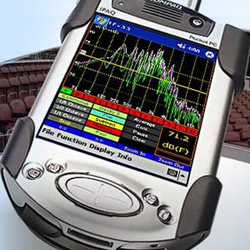
So using an RTA or one of the PC-based analyzers can be a consistent non-perception-based method that’s helpful. But note that this approach sometimes just isn’t practical, and I’ve yet to use a measurement system that provides consistently usable results without also needing “touch up” via ear.
Often there isn’t the opportunity to play a test CD, let alone the problem of subjecting 30,000 people to hearing “check one, two” or pink noise for 15 minutes of tuning.
Simply put, what is needed is a trustworthy, repeatable reference point that can be easily carried and utilized anywhere, anytime without affecting the show, a way to get enough information for an optimized mix without putting a single instrument through the system.
Copying Is Easy
Rather than trying to remember the sound you’re looking for, and hoping your ears are honest, there’s an easier, more dependable method. For example, a small system with an accurate tonal balance already dialed in can serve as a good point of comparison.
Simply, “A-B” the two systems and adjust the big system to sound similar to the smaller one. All that’s really needed is an accurate pair of sealed headphones and a CD that sounds similar to the mix to be achieved.
Though most headphones won’t do many favors in the very low frequency region, a decent pair will provide a very usable reference point from 100 Hz or so, on up. Using the headphones as a real-time comparative reference, play the CD through the system while it’s also cued up in the headphones, and then EQ the system to sound like the headphones.
If the chosen CD is relatively well balanced and mixed, and the engineer has done a reasonable job of copying its sound, the result should be with a surprisingly good system EQ.
Think of the system EQ as the tool for compensating and bringing the venue/system combination to a “correct” tonal balance. Think of channel EQ as the tool for getting the instrument/microphone combination to the “desired” tonal balance.
If done properly, the mix bus of the console should carry signal that is somewhat close in tonal balance to prerecorded music. Therefore, CDs should sound good through the system with no channel EQ.
An offshoot of this – usually used at festivals where it’s not possible to play a preferred CD – is to simply use whatever house music is being played as the comparative reference in my headphones. The system can be EQ’d on the spot with no disruption to the event.
The beauty of this is that if your ears are dull, both the headphones and system will sound dull, and therefore you should still be able to match them up. It can also make you aware that your ears are indeed dull when you experience an overwhelming desire to crank up the high-frequency EQ.
Seeing, Believing
Having a comparative audible reference is one useful tool in the bag of tricks, but not enough to guarantee being on the right track. Another tool is all about using the eyes.
Whether it’s a conventional RTA or a PC-based analyzer, having an accurate visual reference is extremely helpful in preventing a mix from drifting. What’s needed is an analyzer with at least a 30 dB window and 2 dB (or better) resolution.
